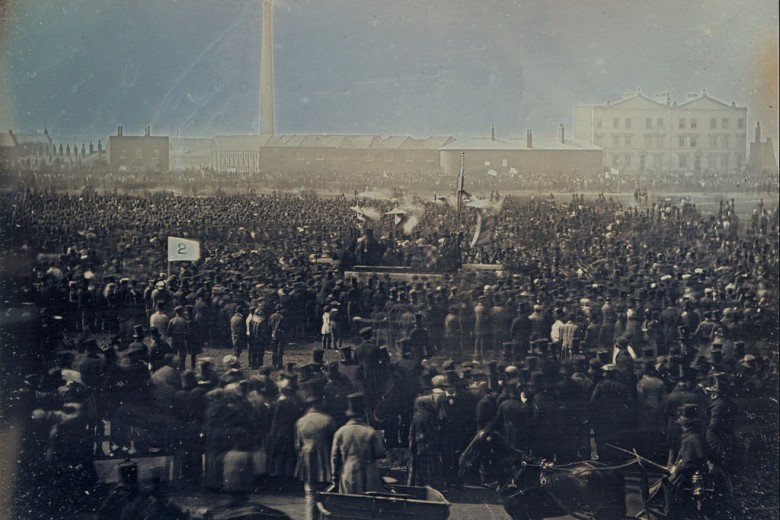
You arrive at an annual meeting with other union members from your industry. It includes representatives from every university in Ontario that has a Canadian Union of Public Employees (CUPE) presence. They hand you a name tag and two drink tickets, and escort you to a room with no chairs. There are no prepared documents. There’s no agenda. Your job, along with the other hundred front-line members of the Ontario University Workers Coordinating Committee (OUWCC), is to set priorities for the sector for the next three years, to tackle obstacles to that work, and to look for concrete ways to build the group’s capacity.
No small feat, but this particular group seems to have pulled it off at their meeting in February.
The Ontario University Workers Coordinating Committee steers a voluntary association of CUPE locals totalling more than 20,000 members working in the university sector. The committee’s activities include coordinating university bargaining and province-wide campaigns, political action on university issues, and facilitating information sharing between locals. It is made up of elected representatives from each campus as well as staff support and representatives from constituency groups.
The group used a facilitation process called “The Art of Hosting.” The process relies on conversations rather than structured agendas, allows participants to identify key issues of interest or concern, and emphasizes relationship building as part of the work. It’s a process that invites diverse perspectives and outside-the-box thinking. Teams of CUPE staff and members who have been trained in the method hosted the meeting.
“People realized very quickly that they had complete control over where it was going to end, and the power to identify the issues they see as important,” says Dave Michor, the national union staff person who supports the work of the Ontario University Workers Coordinating Committee. The Art of Hosting “gave people the opportunity to talk about issues, target methods of finding solutions or developing an action to help them find the solution.”
What flowed from that planning conference in February 2008 set the course for CUPE Ontario’s university sector until 2010. The OUWCC is working to develop the capacity of every local and to increase their strength at the bargaining table.
What the OUWCC is proving is that taking risks and thinking big are powerful ways to organize from the bottom up – relying on the expertise and strengths of rank-and-file members. These members are developing their own skills and abilities as labour leaders. Maybe more importantly, they are seeing the results of working together towards common goals.
The OUWCC is one of five industry-based sectors in CUPE – its others are municipalities, hospitals, school boards and social services. Each has an elected leadership charged with the task of improving working conditions and building better public services. The leaders of the OUWCC have been talking about coordinating their bargaining for ten years in the belief that combining their efforts would give them stronger bargaining positions than going it alone. Although the goal has been clear for a long time, transforming it into action has been a slow process. Weighed against the possibility of failure is the possibility that members will embrace the project and move forward with new energy.
Eggheads and scrambled brains
CUPE’s university sector has about 23,000 members. They do every job on campus from teaching courses to washing floors and fixing the plumbing. The two branches of the union affectionately refer to one another as “eggheads” (the academic workers) and “scrambled brains” (the tradespeople and support staff).
The diversity within the sector is a strength and a challenge. Fifty-five per cent of members are academic workers – teaching assistants and sessional faculty. The other 45 per cent are support workers. Bringing so many different classifications of members together and meeting their needs is ambitious, to say the least.
The leaders of the OUWCC know that using The Art of Hosting, a process that’s entirely directed by members, is a huge risk. “It’s a process of self-awareness and self-development, and it can very quickly fall flat. If there’s no buy-in, it will fall flat. We had a serious concern about that. We thought that academic workers might be intrigued by that challenge, but 45 per cent of the members have a more traditional local structure, and could have said they didn’t want to participate,” says Michor.
Action plans developed by the steering committee are sent back to individual member locals for approval – and so far, there’s been widespread buy-in. Each campus has a representative participating in the planning process, helping members see their personal issues addressed in the action plan. Priorities like wages, health and safety and protections against violence in the workplace were among those chosen this year as target areas for locals to negotiate improvements.
The great divide
A number of years ago, the geographic separation of university workers posed a challenge for organizing the sector. It was hard to provide members from all across Ontario with meaningful opportunities to communicate. Increasingly, though, members are making effective use of technology to stay connected. Regular conference calls, email lists, and social media like Facebook have helped shrink the province and keep everyone informed and connected.
Trying to deal with geographic challenges has always been difficult for unions in Canada. But the OUWCC has seemingly found a balance between centralization and the silo effect that plagues many other labour movement organizations. That’s why involving and motivating rank-and-file members is so important to the OUWCC. Membership in OUWCC is voluntary – locals choose whether or not to belong and contribute a voluntary levy to financially support the group’s work. Currently, 92 per cent of university locals have chosen to affiliate themselves with the group and its goal of provincially coordinated bargaining by 2010.
CUPE’s structure is based on the concept of local autonomy, where locals are given space within the larger organization to develop their own cultures and priorities and to negotiate their own collective agreements. Coordinating over 20 different locals within that environment has obviously been challenging. But the high rate of affiliation shows that it’s possible to work alongside and within existing structures to organize for concrete improvements to both the working conditions of members and the learning conditions of students.
Common issues
OUWCC members have common work environments – a link to each other that helps to make coordinated bargaining practical. Coordinated bargaining can take many forms – some unions have a common bargaining table. In this case, the OUWCC chooses to identify target issues, and locals can tailor their approaches to best meet their needs.
The OUWCC hopes that their pooled efforts will convince the government that the trend of funding cuts for universities needs to change. Their workplace conditions are also dependent on how much public funding is put into the system. The funding to universities, like most public institutions, is controlled by the provincial government.
“The shift toward neo-liberal public policies and the reorganization of government apparatuses has had major effects on working conditions across the province – indeed, throughout the country. In every sector it’s reduced the quality of public services,” says Dan Crow, the university sector’s vice-chair.
This is most immediately visible on campuses in the forms of increased tuition fees and growing debt for students, deferred building maintenance, contracting out of “non-core” functions such as food services and research, and the casualization of work. These changes have had major negative effects on the overall quality of education at Ontario’s universities.
Meanwhile, for non-academic and support workers, job security is taking a hit. Fewer new workers are hired to replace those who retire, which both increases workloads and allows universities to contract out services.
“Universities have the ability to threaten further contracting out and restructuring as a means to pressure locals on campuses to accept concessions in bargaining,” says Crow.
For academic workers, the results of underfunding are largely the same. As faculty members retire, universities are replacing them with sessional instructors who work on a contract basis. Sessionals do much of the same work as faculty: lecturing, marking, meeting with students, running seminars and preparing materials. For this, they receive a fraction of what their counterparts on faculty receive.
“This is forcing sessionals to piece together short-term work across departments and often across universities. For sessionals, job security is virtually non-existent,” says Crow. “Coordinating our bargaining efforts across the province is the key to reversing this trend. The Ontario government needs to put resources toward making our working and learning environments work for us again.”
Coalition building is becoming central to this union campaign. For a labour movement that can no longer afford to address its issues in isolation, part of the group’s strength is working with community partners and student groups. Compelling the government to act is a difficult task for any one union or community group to achieve on its own. Raising public awareness is one way to put pressure on the government to increase funding for universities and reverse the privatization trend.
Members’ voices, members’ power
Members say that one of the best things about being a part of the OUWCC is the new energy and empowerment that it gives to activists. These activists are tradespeople, support workers and teachers. As part of the committee, they sit on working groups, direct and implement campaigns and run province-wide outreach tours of campuses.
Lianne Dubreuil, support staff at Carleton University in Ottawa, speaks of the personal change she has experienced since becoming involved in 2007. When she thinks about the goal of coordinated bargaining, she says: “It’s really exciting, but it’s really scary. I have to learn how to motivate my executive and membership. We’re on the cusp of a history-making moment. It’s challenging, but I feel proud, and honoured, to be a part of it.”
“Gaining knowledge is a key reason for doing this. When we coordinate our bargaining, we’re banding together. The issues that are important to us on our campus are important on all campuses. It empowers all of us,” Dubreuil adds.
Promoting coordinated bargaining – where various locals negotiate on common timelines and focus on a fixed set of priority issues – is important to the OUWCC’s success. But it isn’t an automatic sell. Across the province, there are some significant disparities between collective agreements. Graduate teaching assistants at Brock University, for instance, are paid a considerably lower rate than those at larger comprehensive schools.
Where locals have managed to negotiate strong collective agreements, coordination has been less attractive to members because it’s more difficult to see what they can gain from their participation. But in true social-unionist style (and thanks to the hard work of both the eggheads and scrambled brains), almost every local has seen the advantages of coordinating efforts.
Long road to go
The group of activist members that make up this sector know that they’re making progress, but there’s still much more work to be done. Choosing central issues that matter to members is key to getting buy-in, especially from members who have felt disempowered by traditional representative structures of trade unions. The OUWCC knows that they have an uphill struggle to convince individuals that it’s worthwhile.
“There’s somebody reporting to the locals, so people are starting to understand why coordination is an advantage,” says Ajamu Nangwaya, an OUWCC member. “But there’s still a lot of work to do involving membership at our base level.”
Building solidarity among members who aren’t a part of the steering committee or working groups is a goal that the OUWCC will have to keep squarely in their sights if they’re going to succeed, Nangwaya adds.
In the long term, empowering individual members and locals and democratizing union structures engenders higher expectations for working conditions and a better connection to fellow workers and communities. The OUWCC is about building working-class power. Through coordination and solidarity, workers aim to win gains at the bargaining table. Whether or not they succeed in doing so, the time and effort invested in developing the capacity of activists, union locals and communities will undoubtedly produce dividends in the future.



_780_520_90_s_c1.jpg)


